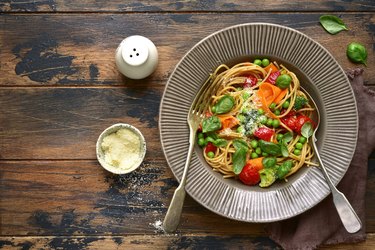If your relationship with fiber starts and ends with thinking, "yeah it's good for you... I think," this one's for you.
National consumption surveys suggest that 95 percent of Americans fall short on getting the recommended amount of fiber daily, usually hitting just 16 of the requisite 25 to 38 grams, according to the American Journal of Lifestyle Medicine. Considering fiber comes with health benefits ranging from keeping you regular to supporting a healthy microbiome, the odds are pretty high that your fiber intake could use some self reflection.
Video of the Day
Video of the Day
We asked Amy Shapiro, RD and founder of Real Nutrition, to share some of the top indications that you aren't getting enough fiber, plus tips on what to do about upping your intake—from filling your plate with more of the right types of fruits and veggies, to adding a supplement like Benefiber Healthy Balance to your daily routine.
Keep reading for 3 signs your fiber intake might be too low.
Sign 1: You're on a low-fiber diet
This one seems obvious, but even some healthy diets can end up being low in fiber—like the low FODMAP diet, which requires eliminating prebiotic-rich foods from your diet for six to eight weeks as a means to sussing out food intolerances and providing relief from digestive distress.
The problem is, prebiotics are a type of fiber, Shapiro explains, so nixing foods like apples, bananas, beans, avocados, and almonds from your plate means you might struggle to reach your daily fiber goal.
That's where a supplement like Benefiber Healthy Balance—which is made of low FODMAP fiber—can come in handy. "I always recommend getting your nutrition from foods, but supplements can help when you can't get enough from food or do not have access to these healthy items," Shapiro says.
The trick is starting out slow and gradually building up your fiber consumption until you hit the recommendation, Shapiro says.
Sign 2: You're constipated
If you can't remember the last time you went number two, that's a major red flag that your fiber intake is probably too low. "Fiber increases transit time," Shapiro explains, which means your trips to the bathroom should be pretty regular if you're good on the fiber front.
Eating more fiber-rich fruits and veggies such as broccoli, spinach, oranges, pears, and berries (all of which also have a high water content, and consuming enough water is key to keeping things moving, Shapiro says), and adding in Benefiber Healthy Balance can help relieve the discomfort of occasional constipation without causing diarrhea. A major win all around.
Sign 3: You're always hungry
Low-fiber foods are satisfying to the soul, but they're not so effective at keeping you satisfied for very long (looking at you, pancakes and pasta).
Hitting your fiber goal will help you feel fuller longer because fiber takes longer to digest than other quickly processed carbs. Since weight gain is another sign you might not be getting enough fiber, according to Shapiro, feeling satisfied after meals can help you manage portion control (and your hankering for dessert), which in turn helps you stay at your body's appropriate weight.
Still can't give up on pasta? Switch to the whole wheat variety, which will deliver about six grams of fiber (compared to just 2.5 grams in white pasta) along with that soul-warming feeling. You'll just probably be less likely to go back for seconds.


